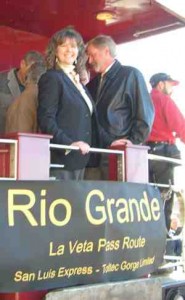Essay by Jim Stiles
Transportation – August 2006 – Colorado Central Magazine
THESE ARE DIFFICULT TIMES for people like me. I love to drive. Nothing soothes me more than a long, empty stretch of road and a full tank of gas and no known destination. I love the rumble of the road, spotting a café in a town, stopping for pie and coffee and listening to locals talk about the price of cattle. I love hearing meadowlarks as I rattle by their perches on fence posts. I like to roll down my window and moo at the standing cattle and wonder if this urge is an affliction that will someday produce its own special medication. I love driving into a thunderstorm and listening to the rhythm of my wipers.
I know I can’t begin to justify my addiction, but there it is. For all of you eco-purists out there who want to call me a hypocrite, I am guilty as charged.
With the price of gasoline stuck in the vicinity of $3, and knowing that to wish the price would fall runs counter to my broader view of energy conservation, I had to do something.
First, I gave up my beloved 1986 GMC pickup which sports 226,000 miles on the odometer and which has faithfully conveyed me for more than a decade, but slurps up gasoline faster than an elephant eats peanuts. It might get 15 mpg on a good day, moving mostly downhill.
It’s now fired up only to keep the battery charged and the fluids circulating and to use only when absolutely necessary. I rely on my 1999 Subaru Forester on a daily basis, and although I’ve never really developed the personal bond with this vehicle that I’ve experienced with other cars in my automotive past, I can say nothing but good things about her performance and efficiency. It always starts, and even at above-freeway speeds manages to get 30 miles per gallon.
But I knew the Subaru and I could do better, and I knew it would require a sacrifice. My motto used to be: “Stay with the traffic flow or get out of the way.” I could move from tranquility to road rage faster than you can say, “slow-moving Winnebago.” Some of my friends suggested counseling.
Instead, I slowed down.
If you’re under 40, you probably don’t remember that in 1973, President Nixon ordered a reduction in speed limits on all federal highways to 55 mph to conserve energy. For a country accustomed to speed, the double-nickel limit shocked the motoring public. Imagine driving across the desert from Green River to Grand Junction, Colo., at 55 mph — it was excruciating. It had never occurred to most Americans that driving at a slower speed had anything to do with fuel economy. I was skeptical and decided to put his proposal to the test. So I drove from Louisville to Cincinnati one weekend to visit my parents and scrupulously monitored my speed both ways. I became a believer when my gas mileage improved by 15 percent.
Still, the national speed limit was opposed by many Americans, particularly the trucking industry. In 1987, lobbyists convinced Congress to raise the speed limit on rural interstate freeways to 65 mph, but it wasn’t until 1995, 21 years after its inception, that the 55 mph speed limit was finally abolished by Congress.
WELL, I HAVE IMPOSED my own national speed limit upon myself. I keep my speed under 60 on two-lane roads and under 65 mph on interstates. I try not to make a nuisance of myself by creating logjams for faster moving vehicles. If there’s no opportunity for cars and trucks to pass, I’ll pull over and let them go by, but if timid drivers who lack passing skills miss clear opportunities to get by me, they’re going to save fuel whether they like it or not.
Keep in mind that I live in the rural West and don’t fight heavy freeway traffic on a daily basis, where trying to drive at 55 is a suicidal gesture. But out here, when the road is relatively empty, I’ve begun riding for free. Did you know that northbound between Monticello, Utah, and Moab, you can coast for nine miles?
The bottom line for all my energy-saving efforts has been an increase in my fuel economy from 30 mpg to 36 mpg — or a 20 percent improvement. On a 15 gallon tank, that means I travel 90 miles farther than I did before.
Beyond that, I feel calmer. With some notable exceptions (those mega-motorhomes!), my road rage has gone into hibernation. Life seems easier now that I’ve removed myself from the fast lane. I’ve never been happier. I almost feel like a damn patriot.
Jim Stiles is a contributor to Writers on the Range, a service of High Country News. He is the publisher of the Canyon Country Zephyr in Moab, Utah.

